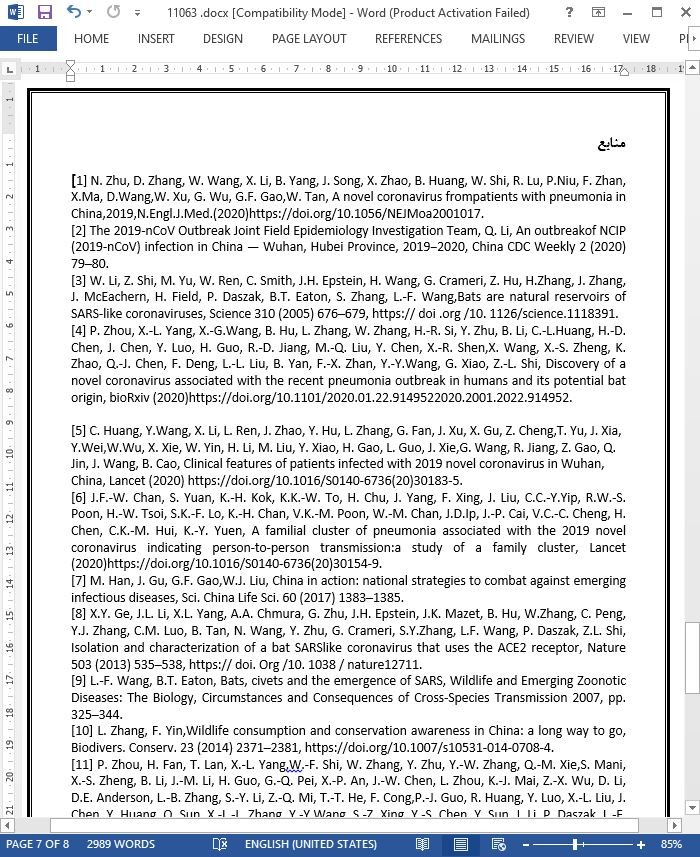
یک استراتژی برای جلوگیری از بیماری های واگیردار مشابه طغیانnCoV-2019
چکیده
کرونا ویروس جدیدی که منشا آن خفاش است در دسامبر2019 در ووهان چین پدیدارگشته و همچنان در حال انتشار در سراسر چین و جهان است.در زمان نگارش این مقاله واکنش عظیم جهانی برای کنترل این بیماری که از فردی به فرد دیگر سرریز میشود به کار گرفته شده است.با این وجود تعلاملات و ارتباطات دوطرفه پرخطر انسان- حیات وحش که منجر به ظهور بیماری SARS-CoV وnCoV-2019 میشود،در عرصه جهانی همچنان در کانونهای ظهور بیماری به قوت خود باقی است.ما برای جلوگیری از بیماری مسری و همه گیر بعدی وابسته به این ارتباطات دوطرفه خواهان پژوهش و سرمایه گذاری در این سه حوزه هستیم:1) مراقبت میان حیات وحش برای شناسایی عوامل بیماری زا پرخطری که حامل آن هستند.2) مراقبت میان مردمی که درتماس با حیات وحش هستند برای شناسایی حوادث سرریزی اولیه ویروس 3)بهبودی امنیت زیستی بازارمربوطه به تجارت حیات وحش.باظهور یک ویروس جدید که هرنقطه از زمین میتواند دورترین عرصه های جهان پیوسته مان را تحت تاثیرقراردهد،مشارکت بین المللی میان دانشمندان برای مطرح کردن این خطرات و جلوگیری از بیماری همه گیربعدی ضروری است.
ظهور یک کروناویروس جدید،nCoV-2019در دسامبر2019 در ووهان منجربه واکنشی جهانی به اولین بیماری مسری این دهه شده است و البته بر دو مسئله حساس و کلیدی تاکید دارد:اول،توانایی سریع و موثرچین برای شناسایی و بررسی یک بیماری نوظهور و دوم،آسیب پذیری مستمر جهانی ما به بیماری های مسری و همه گیر.ازتاریخی که اولین گروه ازاین موارد در27 دسامبر2019 دریک بیمارستان محلی پذیرش شدند،دانشمندان چینی این بیماری را به عنوان یک سندروم جدید شناسایی کرده و کانون آن را بعنوان علت بیماری کشف کرده ودر کمتراز14روز توالی ژنتیکی آنرا به جهان گزارش کردند[1.2].
Abstract
A novel bat-origin coronavirus emerged in Wuhan, China in December 2019 and continues to spread across China and the world. At the time of writing, a massive global response has been implemented to control the disease as it spreads from person to person. Yet the high-risk human-wildlife interactions and interfaces that led to the emergence of SARS-CoV and of 2019-nCoV continue to exist in emerging disease hotspots globally. To prevent the next epidemic and pandemic related to these interfaces, we call for research and investment in three areas: 1) surveillance among wildlife to identify the high-risk pathogens they carry; 2) surveillance among people who have contact with wildlife to identify early spillover events; and 3) improvement of market biosecurity regarding the wildlife trade. As the emergence of a novel virus anywhere can impact the furthest reaches of our connected world, international collaboration among scientists is essential to address these risks and prevent the next pandemic.
The emergence of a novel coronavirus, 2019-nCoV in Wuhan December 2019 has led to a global response to the first epidemic of this decade. It has also highlighted two key issues: First, China's rapid and efficient capacity to identify and investigate a newly emerging disease; and second, our continued global vulnerability to epidemics and pandemics. From the date of the first cluster of cases admitted to a local hospital on December 27, 2019, Chinese scientists identified this disease as a new syndrome, discovered the pathogen as the cause, and reported its genetic sequence to the world in less than 14 days [1,2].
- اصل مقاله انگلیسی با فرمت ورد (word) با قابلیت ویرایش
- ترجمه فارسی مقاله با فرمت ورد (word) با قابلیت ویرایش، بدون آرم سایت ای ترجمه
- ترجمه فارسی مقاله با فرمت pdf، بدون آرم سایت ای ترجمه


